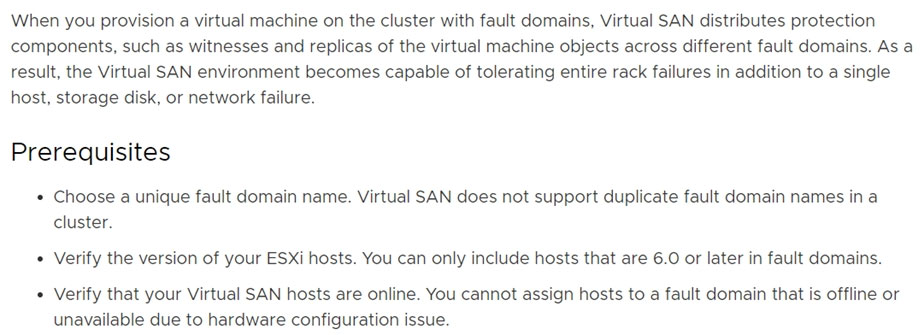A vSAN administrator has three available racks and six vSAN hosts and needs to protect against a rack failure while maximizing resources.
Which two strategies should the vSAN administrator use to achieve this goal? (Choose two.)
A vSAN administrator has three available racks and six vSAN hosts and needs to protect against a rack failure while maximizing resources.
Which two strategies should the vSAN administrator use to achieve this goal? (Choose two.)
CD
Reference:
https://docs.vmware.com/en/VMware-vSphere/6.5/com.vmware.vsphere.virtualsan.doc/GUID-C365ACE8-7485-4463-A12C-71D1917A4930.html

The question is asking for two possibilities, it is not asking for two combined configurations. With RAID6 you need 6 total fault domains minimum. We have six hosts, so R6 can be configured, but there will be no rack awareness. You could also build 3 fault domains manually at the rack level. You then have only 3 fault domains and R6 will not be possible in this case. with 3 fault domains you could use only PFTT=1 and Mirroring.
have those 6 hosts and every host is a FD. The loss of a single rack equals 2 host failures and this is the max RAID-6 can protect us against. https://www.softwaredefinedblog.com/fault-domain-examples-in-vsan/ Example3
Should be A&C
protect against a rack failure So,A&C
6 hosts/3 racks = 2 hosts per rack. If a rack fails, you loose 2 hosts which is outside the fault tolerance of RAID5 FTT1. The questions asks to protect against a rack failure and maximise resources. Therefore the only option is D for both those requirements.
Should be A&C - we do this every day.
Answer is C and D 3 fault domain with raid 6 FTT2 can achieve this
RAID 6 requires 6 total fault domains...
5 Fault Domains
RAID-6 FTT2 requires 6 hosts to work. Since the admin has 6 hosts available the best way to protect for a rack failure is to set 3 fault domains with 2 hosts each and RAID-6 FTT-2. So C and D
You can either have six fault domains or three (not both). RAID 6 requires six fault domains. So you have TWO distinct choices, you can either have RAID6 AND 6 (host-based) fault domains or THREE fault domains at the rack level. Hence A or C.
whoops, I mean C and D :-D
If the administrator puts 2 hosts in each rack, and one rack fails, two hosts will be offline. So in my opinion he should configure RAID6 FTT=2 and define fault domains. So for me it should be C and D
Scroll down to the bottom of this page on Stretched Clusters and Fault Domains: https://docs.vmware.com/en/VMware-vSphere/7.0/com.vmware.vsphere.vsan-planning.doc/GUID-1BDC7194-67A7-4E7C-BF3A-3A0A32AEECA9.html
The question is about rack failure, not disk failure. There are three racks and it does not specify where they are located or their proximity to one another. Stretched Clusters require 3 Fault Domains (not 4 or 6 like the two RAID configs). A 2 node config would put the witness on a node in the same rack so that is not the answer. The only answers left are B and C. This gives us Rack Awareness with one Fault Domain on each of the three racks.
C & D. If you use RAID-5/FTT=1 and you loose a rack, you loose objects too. You could create 3 FD (2 host per RACK) and RAID 1. The another option is use RAID-6/FTT=2, you can loose 2 host (a complete rack).
PFTT must be 2 and 6 fault domains from each host. CD is the correct answer You can configure RAID 5 on all-flash clusters with four or more fault domains. You can configure RAID 5 or RAID 6 on all-flash clusters with six or more fault domains.
The rule is 2*n+1. FNTT=2 is not possible on 3 Fault Domains
if we will take 100GB vmdk on raid 6 we will use 150 GB. on raid 5 we will use 133GB. correct answer is a,c
RAID 5 is FTT=1. The question asks to protect a rack with 2 nodes, that is, FTT=2. Correct answer is C and D.
C&D. Question states "maximizing resources". Raid6 can sustain 2 failures and will protect against rack failure if each host is fault domain.